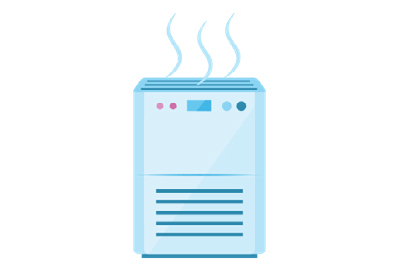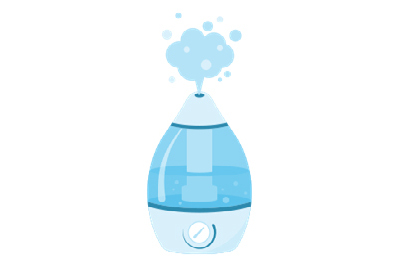Humidity | Overview
Providers and patients: The information below can be downloaded and printed in English and Spanish from the links below.
Your health and humidity

Humidity is the amount of water or moisture in the air. It can affect your child’s health in many ways, especially if they have asthma or allergies.
Good humidity is between 35 and 50 percent.

How can you check the humidity?
Relative humidity compares the actual amount of water in the air to the most amount of water the air can hold.
- Find relative humidity on your weather app.
- Test your home’s humidity (indoor air) using a device called a hygrometer.

Why does humidity matter?
If the range is below or above the 35 to 50 percent range, the air can make your child cough and have a hard time breathing. Sudden changes in humidity can also make breathing conditions like asthma worse.
Low humidity
Low humidity can result in dry air, which can cause:
- difficulty breathing
- dry skin
- itchy eyes
- nosebleeds
High humidity
High humidity can cause difficulty breathing by making it easier for the growth of:
- dust mites
- mold
- pollen
- allergens
How can you change the humidity in your home?
Humidifiers and dehumidifiers are both used to control humidity. Learn the difference so that you know when to use each one.

Humidifier
Adds moisture into the air to raise the humidity.
It helps with:
- dry skin
- breathing passages
- allergies
When do you use it?
Use typically in the dryer months:
- winter
- spring
What are the different types?
- Warm mist is best for children with asthma or allergies.
- Don’t use cool mist. It can spread particles of allergens and make air quality worse.

Dehumidifier
Absorbs moisture out of the air to lower the humidity.
It helps with:
- breathing
- asthma symptoms
- mold and mildew growth
When do you use it?
Use typically in conditions with high moisture:
- summer
- basements
- areas with water leaks
- after flooding
What are the different types?
- refrigerant: for a limited area, most effective at typical room temperatures
- desiccant: absorbs water from the air using a physical material
- whole house: ventilation systems
How can you use them best?
Both humidifiers and dehumidifiers work best when used in well-ventilated areas (with good airflow). This helps moisture get distributed evenly.

How do you keep humidifiers and dehumidifiers clean and safe?
Both humidifiers and dehumidifiers handle moisture. This can make them grow mold and mildew, which can make allergies and asthma symptoms worse.
- Always use clean, fresh water.
- Replace filters as recommended.
- Clean after each use (or at least weekly) in a well-ventilated area.
Resources
For more resources on humidity, visit:
This document was supported by the American Academy of Pediatrics (AAP) as well as the Asthma and Allergy Foundation of America, New England Chapter. It was funded (in part) by a cooperative agreement with the Centers for Disease Control and Prevention/Agency for Toxic Substances and Disease Registry (CDC/ATSDR). The U.S. Environmental Protection Agency (EPA) supports the PEHSUs by providing partial funding to CDC/ATSDR through an interagency agreement. The findings and conclusions presented have not been formally disseminated by CDC/ATSDR or EPA and should not be construed to represent any agency determination or policy. Use of trade names that may be mentioned is for identification only and does not imply endorsement by the CDC/ATSDR or EPA.

